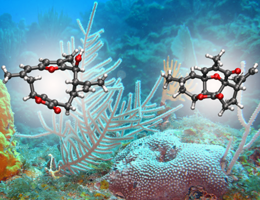Making light do the work of intricarene synthesis

Intricarene was first isolated from a Caribbean coral. Now an Ludwig Maximilian University of Munich team has, for the first time, photochemically synthesized the compound in the laboratory, using levels of UV radiation like those that prevail in the coral's natural habitat.
An LMU research team has successfully achieved the first biomimetic synthesis of the natural product intricarene. The substance was first discovered in the Caribbean sea plume Pseudopterogorgia kallos, and the synthetic route used a photochemical method which utilizes a light source that reproduces the lighting conditions encountered in the coral's marine environment. The scientists also elucidated the complicated and surprising mechanism that underlies the light-induced reaction cascade. The interdisciplinary project was carried out by members of the Collaborative Research Center on "Dynamics and Intermediates in Molecular Transformations", and their findings are reported in Nature Communications.
"A compound which was previously isolated from this species of sea plume has been found to exhibit antimalarial activity and a significant level of cytotoxicity against two human cancer cell lines. The pharmacological and biological properties of intricarene itself have not yet been investigated, because the substance was only available in minimal amounts," says Dirk Trauner, Professor of Chemical Biology and Genetics at LMU's Department of Chemistry. In collaboration with groups led by his LMU colleagues Regina de Vivie-Riedle (Professor of Theoretical Chemistry) and Eberhard Riedle (Professor of Experimental Physics), Trauner and his team have now accomplished the first laboratory synthesis of intricarene under conditions that mimic those to which its producer organism is naturally exposed. This feat has also allowed them to tease out the details of the complex reaction mechanism involved in its synthesis.
All facets of photochemistry come into play
The crucial ingredient required for the synthesis of intracarene is – light. Indeed, photochemical reactions that comprise the final steps of natural biosynthetic pathways appear to play a central role in the formation of both intricarene and other furanocembranoids. During photosynthesis in plants and algae, solar energy is first converted – via a whole series of steps – into chemical energy, which is then harnessed for the production of simple organic nutrients from carbon dioxide and water. However, synthesis of intricarene is driven directly by radiant energy.
Trauner and his team began with a derivative of the compound bipinnatin J, which had been isolated from the coral, and exposed it for 8 hours to light from a reptile lamp (of the kind used in indoor reptile enclosures), whose emission spectrum resembles that of sunlight. Chemical analysis revealed that among the major products of the light-driven reaction were intricarene and a previously unknown byproduct. "This is the first time that intricarene has been synthesized in the laboratory under biomimetic conditions, using light alone at moderate temperatures and in the absence of highly reactive chemicals," says Dirk Trauner.
By comparing the emission spectrum of the lamp with calculated and measured absorption spectra of the precursor, Eberhard Riedle deduced that excitation of a weak absorption band at 360 nm is essential for the formation of intricarene. "The long exposure time used in our experiments mimics the conditions found in the coral's natural habitat, and provides for the photochemical initiation of the reaction," Riedle adds.
Discover the latest in science, tech, and space with over 100,000 subscribers who rely on Phys.org for daily insights. Sign up for our free newsletter and get updates on breakthroughs, innovations, and research that matter—daily or weekly.
On the basis of quantum chemical calculations, Regina de Vivie-Riedle's group then elucidated the mechanism responsible for the cascade of reactions that leads from the bipinnatin J derivative to the final product. Intricarene is derived from a oxidopyrylium intermediate via a photochemically driven cycloaddition step, which results in the coupling of two unsaturated systems to form a ring. The calculations suggested that the different steps require the formation of triplet states, excited states characterized by the possession of two unpaired electrons. "Their long lifetimes ensure that the reactants can undergo the various steps in the reaction cascade while in the excited state. In this way, the steep energy barriers they would encounter upon relaxation into the ground state are avoided," as Regina de Vivie-Riedle explains. Indeed, even if reactants do decay to the ground state during the long series of reactions necessary for intricarene formation, continued absorption of light by the oxidopyrylium derivative ensures that the excited states can be readily replenished.
The greatest surprise for the team was that, as de Vivie-Riedle points out, "the formation of this relatively small natural product exemplifies all the facets of photochemistry, from light absorption to the redistribution of radiant energy." Further photochemical experiments with a different derivative of bipinnatin J confirmed the theoretically derived reaction mechanism. "Detailed understanding of this mechanism should make it possible to produce intricarene in quantities large enough for its potential as a cancer chemotherapeutic agent to be properly investigated," de Vivie-Riedle adds.
More information: "Photochemical formation of intricarene" Nature Communications 5, Article number: 5597 DOI: 10.1038/ncomms6597
Journal information: Nature Communications
Provided by Ludwig Maximilian University of Munich



















